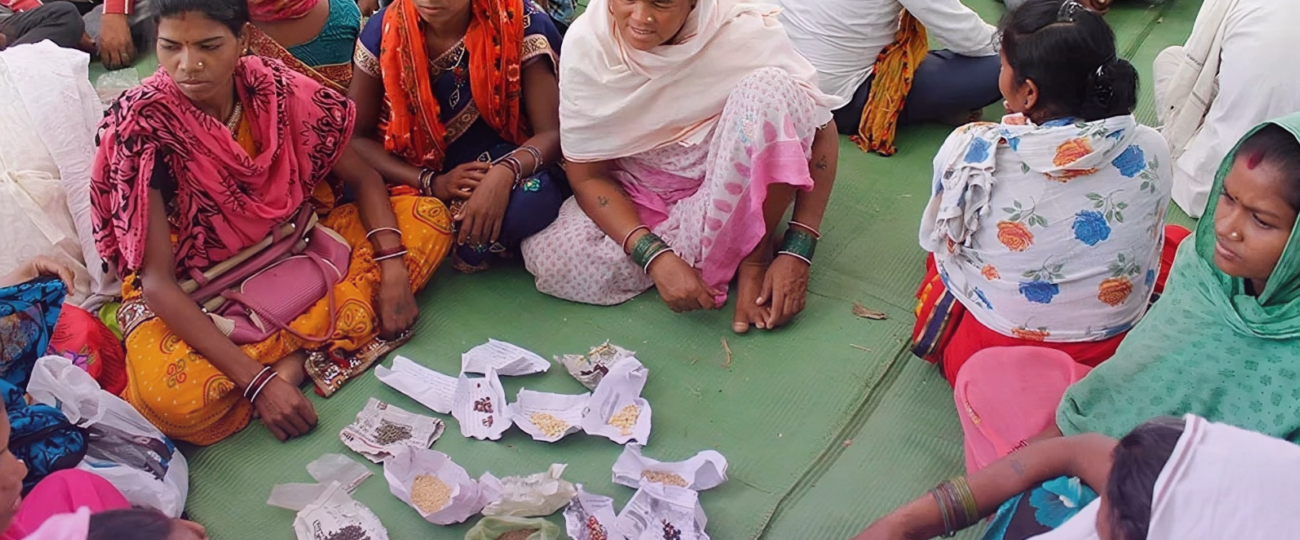Sehjo Singh is part of the Alternatives Confluence (Vikalp Sangam in Hindi), a platform of organizations and movements defending nature, communities, and food sovereignty in India. Sehjo granted this interview during the 13th International Meeting of the World March of Women in Ankara, Turkey. There was a significant turnout of delegations coming from Asian countries, including militants with the WMW and ally organizations.
Capire spoke with Sehjo about the history of building feminism in India and the current forms of resistance and alternatives proposed by women in the region. Sehjo argued that anti-patriarchal struggles include challenging the caste system and the fight for land, coming from the reality and needs of grassroots women. She said the first battle to be waged is to recognize how women farmers are key to food production and biodiversity protection. “It’s not ‘the women who contribute’, I would say that it’s ‘the women who hold it up’.”

First of all, could you please introduce yourself and your political trajectory?
I had the good fortune of having an upbringing with parents who were part of something called the Sufi movement in India, so I had a very liberal upbringing. I grew up after the emergency and rise of strong left-oriented movements in the country, so it was natural for me to have a outward looking and justice-oriented wishing for my own life. That’s the circumstances which are more responsible for the person that I am.
While I was still in college, the human rights movement and the women’s right movement really picked up. Human rights, because of the experience of a suppression of rights that our country had. And women’s rights, probably because of the time when it had come. This is the decade of 1970, where there were lots of women’s rights reports and studies launched across the world. It really brought together a lot of women in India. Of course these were first the privileged women, but their own outlook was born to be connected with the grassroots movements.
It’s interesting that one of the earliest women’s mobilizations in the country was about ecology. It was called ‘The Chipko Movement’. ‘Chipko’ means to hug, to stick, and the movement was to hug the trees in a valley in the Himalayas to stop deforestation. Later, there were some movements and laws regarding women’s right to property, to change the way the court treated rape… Many laws changed, but there was also a lot of mobilization on the ground.
Those were days when women were still being beaten up or even killed for something called dowry. It’s a very strange concept within the caste Hindu societies. It means that if you are giving your daughter to someone, you also have to pay damages, which is so counter-intuitive and illogical. It’s like if a woman was a burden being passed on, with an expectation which cannot be fulfilled. In that time, it started coming to light and the media started reporting about it. I remember that, as a young girl, along with other girls I would go to people’s houses who had demanded the dowry and I would paint their fences or houses black.
There is a deep connection between feminism and ecology. Inequality and injustice start at home. That’s where we lay the foundation of how human beings can treat each other unequally, how human beings can oppress each other. Patriarchy is a system in which everybody participates. In India, patriarchy is laid over by something which is absolutely the most evil genius that you could have ever thought of: the caste system, which is refusing to go away.
Caste system needs the patriarchy to remain strong.
Sehjo Singh
If women had their own choices and rights it would take a moment for caste to be demolished, because then women would marry, love and reproduce of their own choice, which the caste system cannot afford. The treatment between human beings is very deeply connected to how people treat nature.
How women have participated in the movements for agroecology and forest protection? What are the women’s contributions in these processes?
I would put it in other way: it’s not ‘the women who contribute’, I would say that it’s ‘the women who hold it up’. Women are the small holder farmers, are the people who stay at home when the men migrate. It’s the women who nurture. It’s also not just women, it’s the poorest women.
The poorest women, the least privileged women, are who actually hold the ground on agroecology.
Sehjo Singh
They are women farmers with all kinds of talents. The combination of Adivasis (the Indigenous people in India) and the Dalits (the word for ‘The Untouchables’) is what holds the actual ground of the forest defense, the seed saving or the cooperation which any natural farming needs.
More and more, whatever it is, it comes into the commercial sector. When organic farming becomes an elite proposition, somebody else is credited for women’s work. These women have been organic farmers by default. The most important thing for women has been and should be to recognize themselves as farmers. That is the first battle: the fight for the idea that a woman is a farmer. The patriarchal concept is that the woman belongs to the farming household and her labor is part of the household. She is the head of the household and she’s not even paid for it.
This is a battle not only with the government, or academics, researchers, people who count statistics, or even the women themselves. The words ‘woman farmer’ become known. Now I remember struggling with these words in the early 1990s and nobody knew it. That time the Internet was very new. I wanted to put up a website for women farmers, and nobody understood what I was talking about.
Let’s talk about feminist struggle currently in India. What is the women’s role in political massive mobilizations nowadays?
It is very interesting to see that the women’s mobilization now is not happening with the people who are ‘aware of the terms’. They are not the ‘cool class’. I will give you an example: the most impressive mobilization recently was by sports women in India who had been molested and had sexual harassment by the Wrestling Federation Chief. He was very deeply politically connected, and in the Court nobody could do anything about him. So these women came onto the roads to talk about sexual harassment. They are not the women who have been brought up in a way that they could talk about such things, but they were able to bring it out. This is also reflected now in the media: that they cannot dismiss women’s issues like that.
However, the overall atmosphere is not conducive to anyone’s rights. One is deeply worried about the narratives of “women as a goddess”, “women on a pedestal”, “women to be worshiped”, versus “women as an equal”. The right wing says: “of course we worship women, but of course we won’t allow them to be equal — and if it comes to Dalit women, we don’t even care.” There have been disturbing cases of rape and murder of Dalit women which have been hushed.
These are not the best days, but this kind of mobilization that has happened are very unlikely to retract. It has come from a long way and it’s there to stay.
Sehjo Singh
Now you are joining us in the 13th International Meeting of the World March of Women, being part of the Asian region delegation. What regional challenges do you observe?
The World March of Women really pleased me because it is a political movement. The most important thing to connect women in Asia would be to connect with what they are talking about and worried about. They’re definitely worried about forests, seeds, the education of the girls, the nutrients and food safety of their entire families. They’re very worried about water and how much longer they will have groundwater or other resources.
The best way is to connect, to see how their fights can be won, and to be able to give them examples of good and successful mobilizations from other parts of the world with women like them. Times are tough, and I think that we will only find the strength on the ground, in people who are together, and not in any charismatic leader or that kind of messiah that some may be seeking. We should look towards the ground, not above.
______




